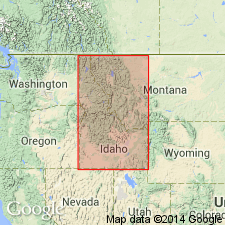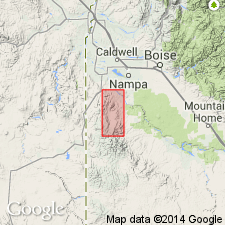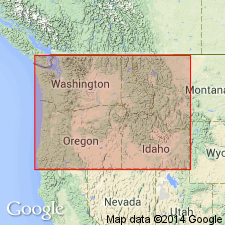
- Usage in publication:
-
- Salmon Creek Volcanics
- Modifications:
-
- First used
- AAPG geologic province:
-
- Great Basin province
Summary:
First use of the Salmon Creek Volcanics. Age is Miocene(?).
Source: GNU records (USGS DDS-6; Menlo GNULEX).

- Usage in publication:
-
- Salmon Creek Volcanics
- Modifications:
-
- Named
- Dominant lithology:
-
- Volcanics
- Basalt
- Andesite
- Breccia
- Pyroclastics
- AAPG geologic province:
-
- Snake River basin
Summary:
Name proposed for sequence of volcanic rocks restricted in exposure to 12 sq mi in northwest portion of Reynolds Creek watershed, Owyhee Co, ID, Snake River basin. Type exposures are along east-flowing reach of Salmon Creek (for which unit is probably named), Owyhee Co. Contains oldest volcanic rocks found in map area. Rests unconformably on granitic basement (Late Cretaceous?) and is overlain by rocks of Reynolds Basin Group (new). In northern part of outcrop area, consists of four readily mappable units: 1) dark-greenish-gray porphyritic olivine basalt at base is overlain by 2) gray, flaggy to platy andesite and dark-grayish-brown or reddish-brown olivine basalt flows with intercalated red and purple breccias, which in turn are overlain by 3) basaltic pyroclastics, followed by 4) a single thick pyroxene andesite flow, fed by dikes that cut the pyroclastic unit. Distribution of Salmon Creek is limited by depositional localization near eruptive center(s), marginal removal due to erosion and uplift, and restriction by pre-existing topography. Though not known with certainty, a Miocene age is assigned because of lithologic similarity to rocks believed to be of this age in eastern and central OR. Measured sections.
Source: GNU records (USGS DDS-6; Denver GNULEX).

- Usage in publication:
-
- Salmon Creek Volcanics of McIntyre (1972)
- Modifications:
-
- Geochronologic dating
- Age modified
- AAPG geologic province:
-
- Snake River basin
Summary:
Pg. 11, geologic time scale (inside front cover). Salmon Creek Volcanics of McIntyre (1972). Sample from a trachytic andesite with microphenocrysts of clinopyroxene and olivine pseudomorphs in a fine-grained holocrystalline matrix of plagioclase, and opaques. Collected in Salmon Creek, Lat. 43 deg. 17 min. 05 sec. N., Long. 116 deg. 49 min. 43 sec. W., in NE/4 sec. 5, T. 2 S., R. 4 W., Sands Basin 15-min quadrangle, Owyhee County, Idaho. K-Ar age 30.6 +/-1.0 Ma (whole-rock); this is probably a minimum age for the andesite. Data from Ekren and others, 1981 (USGS Misc. Geol. Inv. Map I-1256). Ages calculated using decay constants of Steiger and Jager, 1977 (Earth Planet. Sci. Letters, v. 36, p. 359-362). [Age considered Oligocene (from Geologic Names Committee, USGS, 1983 ed. geol. time scale, with additions from N.J. Snelling, 1985, The Geol. Soc. Mem., no. 10).]
Source: Publication.
For more information, please contact Nancy Stamm, Geologic Names Committee Secretary.
Asterisk (*) indicates published by U.S. Geological Survey authors.
"No current usage" (†) implies that a name has been abandoned or has fallen into disuse. Former usage and, if known, replacement name given in parentheses ( ).
Slash (/) indicates name conflicts with nomenclatural guidelines (CSN, 1933; ACSN, 1961, 1970; NACSN, 1983, 2005, 2021). May be explained within brackets ([ ]).

